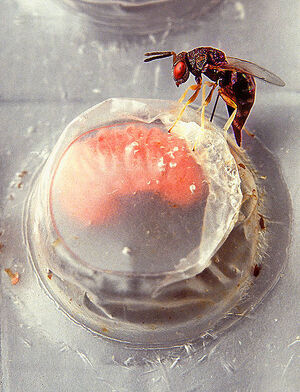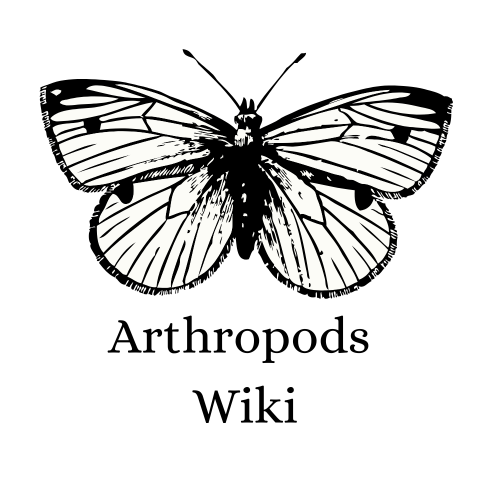(Created page with "right|300pxThe '''Asian giant hornet''' (''Vespa mandarinia''), including the subspecies Japanese giant hornet (''Vespa mandarinia japonica''),[1] col...") Tag: sourceedit |
(File added via photo placeholder) |
||
| Line 1: | Line 1: | ||
| − | [[File: |
+ | [[File:Female Catolaccus grandis wasp.jpg|thumb|300px|right]]The '''Asian giant hornet''' (''Vespa mandarinia''), including the subspecies [[Japanese giant hornet]] (''Vespa mandarinia japonica''),[1] colloquially known as the yak-killer hornet,[2] is the world's largest hornet, native to temperate and tropical Eastern Asia. They prefer to live in low mountains and forests while almost completely avoiding plains and high altitude climates. ''V. mandarinia'' creates nests by digging, co-opting pre-existing tunnels dug by rodents, or occupying spaces near rotted pine roots.[3] It feeds primarily on larger insects and honey from honey bee colonies.[4] Some dimensions of this hornet are a body length of 45 mm (1.8 in), a wingspan of about 75 mm (3.0 in), and stinger of 6 mm (0.24 in) which injects a large amount of potent venom. |
==Taxonomy and phylogeny== |
==Taxonomy and phylogeny== |
||
===''Vespa''=== |
===''Vespa''=== |
||
Revision as of 00:32, 29 August 2018

The Asian giant hornet (Vespa mandarinia), including the subspecies Japanese giant hornet (Vespa mandarinia japonica),[1] colloquially known as the yak-killer hornet,[2] is the world's largest hornet, native to temperate and tropical Eastern Asia. They prefer to live in low mountains and forests while almost completely avoiding plains and high altitude climates. V. mandarinia creates nests by digging, co-opting pre-existing tunnels dug by rodents, or occupying spaces near rotted pine roots.[3] It feeds primarily on larger insects and honey from honey bee colonies.[4] Some dimensions of this hornet are a body length of 45 mm (1.8 in), a wingspan of about 75 mm (3.0 in), and stinger of 6 mm (0.24 in) which injects a large amount of potent venom.
Taxonomy and phylogeny
Vespa
Vespa mandarinia is a species of wasp that falls under the order Hymenoptera. Its genus Vespa is composed of hornets. The genus is defined by a nearly circular (when viewed from the front) or dorsoventrally depressed head. The upper half of their mid-cranial sulcus is developed and may appear above the clypeus. A patch of the palate is sclerotized and extends towards the lateral side. Due to this development, it is rare to find a weak and fragmented palate amongst this genus. A median patch is occasionally present in species within the genus. The mandible is short and apically tridentate. Unlike Vespula, the first tooth does not distinctively project. The density of denticles on the maxilla vary. The collar process is thick, complex, and branched. Outside of this, the atrial wall has many intricacies and visible spines.[3]
Subdivision of the genus into subgenera based on adult features has been attempted (e.g., [6]) but has been abandoned, due to the anatomical similarity amongst species and the fact that behavioral similarity is not associated with phylogeny.
Vespa tropica
Along with 7 other species, V. mandarinia is a part of the V. tropica group, defined by the single notch located on the apical margin of the seventh gastral sternum of the male. The new V. tropica species group comprises V. mandarinia and V. soror. The triangular shape of the apical margin of the clypeus of the female defines the species. Furthermore, the vertex of either species is enlarged and the shape of the apex of the aedeagus is distinct.
Description
Depending on their classification, V. mandarinia can range anywhere from 3.5 (workers) to 5.5 (queen) cm on average. Regardless of gender, the hornet’s head is a light shade of orange and its antennae are brown with a yellow-orange base. Its eyes and ocelli are dark brown to black. V. mandarinia is distinguished from other hornets by its pronounced clypeus and large genae. Its orange mandible contains a black tooth that it uses for digging.[8]
The thorax is dark brown, with two grey wings varying in span from 3.5 to 7.5 cm. Its forelegs are brighter than the mid and hind legs. The base of the forelegs is darker than the rest.
The abdomen alternates between bands of dark-brown or black and a yellow-orange hue (consistent with its head color). The sixth segment is yellow. Its stinger is up to 10 mm long and contains a potent venom that, in cases of multiple wasps stinging simultaneously, can kill a human.
Queens and workers
The main difference between queens and workers is that queens are considerably larger. Queens can exceed 50 mm (2.0 in) while workers are between 35 mm (1.4 in) to 40 mm (1.6 in). The reproductive anatomy is consistent between the two but workers do not reproduce.
Drones
Drones (males) are similar to females but lack a stinger. This is a consistent feature among Hymenoptera.
